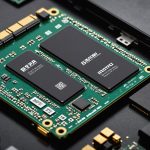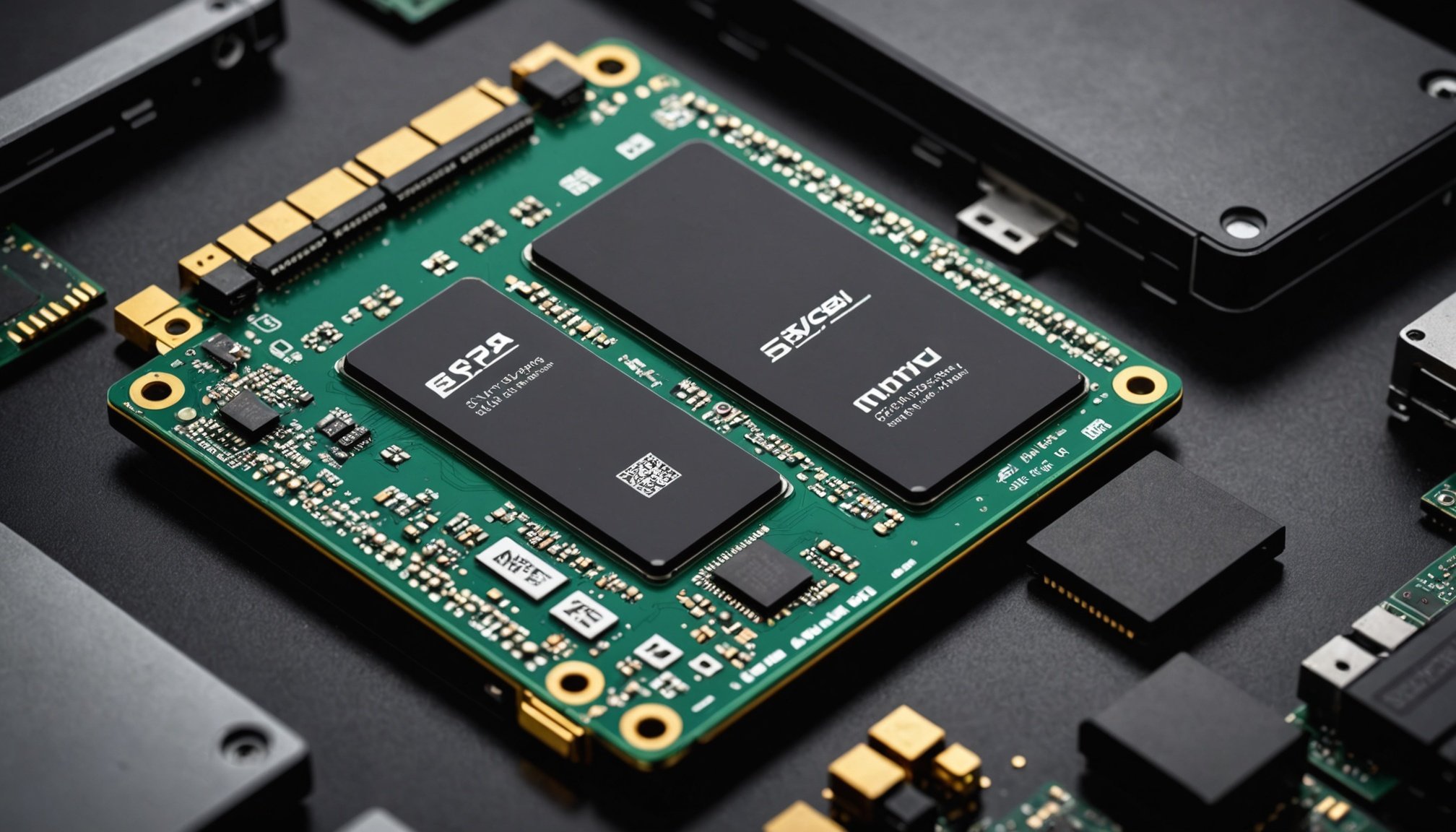Why Choose M.2 NVMe SSDs Over Traditional SATA SSDs?
In the ever-evolving world of computer storage, the choice between different types of solid-state drives (SSDs) can be daunting, especially when considering the nuances between M.2 NVMe SSDs and traditional SATA SSDs. In this article, we will delve into the benefits of opting for M.2 NVMe SSDs, exploring why they stand out as the superior choice for many users.
Understanding the Basics: M.2, SATA, and NVMe
Before we dive into the advantages of M.2 NVMe SSDs, it’s essential to understand the basics of each technology.
What is M.2?
M.2 is a physical form factor for SSDs, designed to be compact and versatile. These drives connect directly to the motherboard without cables, making them ideal for slim laptops, desktops, and small form factor PCs. However, the M.2 form factor itself does not determine speed; it’s the interface used (SATA or NVMe) that makes the difference[2].
What is SATA?
SATA (Serial Advanced Technology Attachment) is a common interface for connecting storage devices in computers. SATA-based M.2 SSDs use this interface, which caps out at around 6Gbps, translating to speeds of about 550-600 MB/s. While this is significantly faster than traditional hard disk drives, it falls short of the performance offered by NVMe SSDs[1].
Topic to read : Mastering Performance: The Complete Blueprint for Enhancing Your Intel NUC as a Superior Plex Media Server
What is NVMe?
NVMe (Non-Volatile Memory Express) is a protocol specifically designed for SSDs, leveraging the high-speed PCIe (Peripheral Component Interconnect Express) interface. NVMe SSDs achieve transfer speeds that far exceed those of SATA SSDs, making them ideal for demanding applications such as gaming, content creation, and professional workloads[1].
Speed and Performance: The Core Advantage
One of the most compelling reasons to choose M.2 NVMe SSDs is their unparalleled speed and performance.
Data Transfer Speeds
M.2 NVMe SSDs can achieve data transfer rates up to 7,500 MB/s, significantly outpacing the 550-600 MB/s of SATA SSDs. This is because NVMe drives utilize multiple PCIe lanes, whereas SATA drives are limited to a single lane. For example, on a PCIe x4 lane, NVMe SSDs can reach speeds up to 31.5 Gb/s, making them among the fastest storage solutions available[1].
Latency and Parallel Operations
NVMe SSDs also offer lower latency and support for parallel operations with up to 64,000 commands in a single I/O queue. This capability enhances performance in environments requiring high levels of data throughput and low latency, making NVMe SSDs the go-to choice for high-performance computing needs[1].
Key Differences at a Glance
Here is a comparative table highlighting the key differences between M.2 SATA SSDs and M.2 NVMe SSDs:
| Aspects | M.2 SATA SSD | M.2 NVMe SSD |
|---|---|---|
| Interface | SATA (6Gbps) | PCIe (up to 128Gbps) |
| Speed | ~500–550 MB/s | ~2,000–7,000 MB/s |
| Latency | Higher | Lower |
| Cost | Lower | Higher |
| Compatibility | Supported on most systems | Requires NVMe-compatible motherboard |
| Use Case | Everyday tasks, light gaming | Heavy workloads, gaming, editing |
Practical Applications and Use Cases
The choice between M.2 SATA and M.2 NVMe SSDs largely depends on your specific needs and use cases.
Everyday Use and Light Gaming
For users who primarily engage in everyday tasks such as web browsing, office work, and light gaming, M.2 SATA SSDs are a reliable and cost-effective option. They offer sufficient performance for these tasks and are widely compatible with most systems[2].
High-Performance Needs
However, for those who require high-performance storage—such as gamers, content creators, and professionals—M.2 NVMe SSDs are the clear choice. These drives provide the blazing-fast speeds and low latency necessary for demanding applications.
- Gaming Performance: NVMe SSDs significantly enhance gaming performance by reducing load times and improving overall responsiveness. For example, loading a game like “The Witcher 3” can take less than 10 seconds with an NVMe SSD, compared to over 30 seconds with a SATA SSD[4].
- Content Creation: For video editors and other content creators, the high-speed data transfer of NVMe SSDs is crucial. It allows for smoother workflow and faster rendering times, making it an indispensable tool for professionals.
Energy Efficiency and Space Considerations
In addition to their superior performance, M.2 NVMe SSDs offer several other benefits that make them an attractive choice.
Energy Efficiency
M.2 NVMe SSDs generally consume less power than traditional hard drives and even SATA SSDs. This lower power consumption is critical for battery-operated devices, translating to longer battery life. For instance, an M.2 NVMe SSD might consume around 2-3 watts during active use, compared to the 6-8 watts of a traditional hard drive[1].
Space Efficiency
The compact design of M.2 SSDs makes them ideal for devices where space is limited. Unlike traditional SSDs or hard drives, M.2 SSDs are rectangular cards that come in various lengths but are typically 22 mm wide. This form factor allows for efficient use of space in PCs and laptops, making them suitable for high-performance applications in compact devices[1].
Future-Proofing and Compatibility
As technology continues to evolve, it’s important to consider the future-proofing of your storage solutions.
Compatibility Issues
M.2 NVMe SSDs require a motherboard that supports the NVMe protocol and PCIe connections. While this may limit their compatibility with older systems, it ensures they are optimized for the latest hardware. In contrast, M.2 SATA SSDs are more widely compatible but may feel outdated as NVMe becomes the standard[2].
Advancements in Technology
The future of storage technology looks promising, with advancements such as PCIe 5.0 SSDs and NVMe-over-Fabrics (NVMe-oF) technology on the horizon. These innovations will further push the boundaries of data transfer speeds and performance, making M.2 NVMe SSDs an even more compelling choice for those looking to stay ahead of the curve[1].
Installation and Maintenance
Installing an M.2 SSD is relatively straightforward, but there are a few key points to consider.
Installation Steps
To install an M.2 SSD, you need to power off your computer, remove the screw from the M.2 slot, insert the SSD at a 30-degree angle, and secure it with the screw. Ensuring the notch aligns properly is crucial. After installation, checking the BIOS settings can help confirm that the SSD is detected by the system[1].
Maintenance Tips
- Regular Updates: Ensure your BIOS is updated to support the latest storage technologies.
- Proper Cooling: Since M.2 SSDs can generate heat during intense use, proper cooling mechanisms are essential to maintain performance and longevity.
- Data Management: Regularly clean up unnecessary files and use disk management tools to optimize your SSD’s performance.: Why M.2 NVMe SSDs Are the Superior Choice
In conclusion, M.2 NVMe SSDs offer a plethora of benefits that make them the superior choice over traditional SATA SSDs. Here are some key takeaways:
- Faster Speeds: NVMe SSDs achieve data transfer speeds up to four times faster than SATA SSDs.
- Low Latency: NVMe SSDs provide lower latency and support for parallel operations, enhancing overall system performance.
- Energy Efficiency: NVMe SSDs consume less power, making them ideal for battery-operated devices.
- Space Efficiency: The compact design of M.2 SSDs makes them perfect for devices with limited space.
- Future-Proofing: NVMe technology is becoming the standard for high-performance storage, ensuring your investment remains relevant in the future.
Final Thoughts and Recommendations
When deciding between M.2 SATA and M.2 NVMe SSDs, consider your specific needs and budget. Here are some final recommendations:
- For Everyday Users: If you engage in basic tasks like web browsing and office work, an M.2 SATA SSD might be sufficient and cost-effective.
- For High-Performance Needs: If you are a gamer, content creator, or professional requiring high-speed storage, an M.2 NVMe SSD is the clear choice.
In the words of a tech enthusiast, “The difference between an M.2 SATA SSD and an M.2 NVMe SSD is like the difference between a sports car and a family sedan. Both will get you where you need to go, but one will get you there much faster and with a lot more style.”
By choosing an M.2 NVMe SSD, you are not just upgrading your storage; you are transforming your computing experience.





